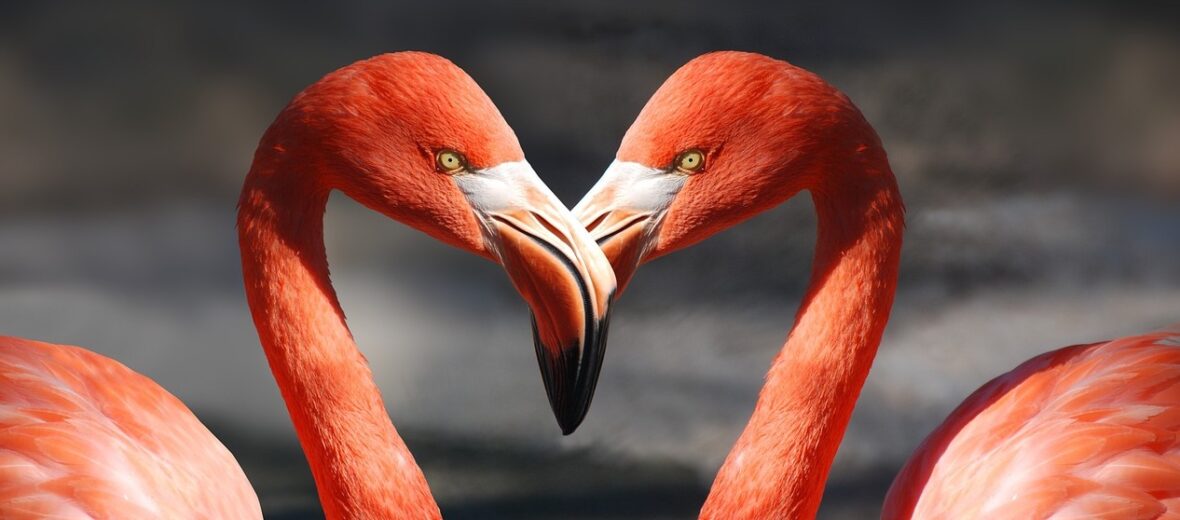
The American flamingo, aka Caribbean flamingo or rosy flamingo, Can be found along the coastlines of southern and southeastern North America, the Caribbean, eastern Central America, northern South America, and a small population also dwells on the Galápagos Islands. They prefer freshwater and saline estuaries, lagoons, mudflats, coastal and inland lakes. Due to an abundant and increasing population overall, these birds are listed as Least Concern by the IUCN.
First the Stats…
Scientific name: Phoenicopterus ruber
Weight: Up to 8 lbs.
Length: Up to 57.08 inches
Wingspan: Up to 5 feet
Lifespan: Up to 50 years
Now on to the Facts!
1.) As of 2020, there were an estimated population in excess of 205,000 wild individuals. The most recent estimate is closer to 300,000+.
2.) These are the only naturally occurring flamingos to live in North America.
3.) While being the largest flamingos in the Americas, then are smaller than greater flamingos.
4.) A group of flamingos is called a colony, flamboyance, regiment, or stand.
5.) Flamingos are social animals that dwell in large colonies of up to several thousand individuals.
But wait, there’s more on the American flamingo!
6.) American flamingos spend most of their day feeding.
7.) Algae, brine, brine shrimp, shrimps, mollusks, marine worms, and aquatic insects are all on the menu.
Did you know…?
American flamingos are very vocal. They produce a quiet gabbling sound when feeding, a grunt or growl when courting, and a honking sound while in flight.
8.) These birds are wary of humans and will fly away when approached.
9.) While generally social, these birds are also very territorial when it comes to finding a good feeding spot and will ward off other flamingos with a threatening display if another gets too close.
10.) Even though these birds aren’t considered true migratory birds, they will relocate to new patches of water to find food. This makes them nomadic.
But wait, there’s still more on the American flamingo!
11.) These birds are diurnal (active during the day), like all flamingos.
12.) American flamingos are monogamous (mate for life).
Did you know…?
Up to 30% of their day is spent preening their feathers and spreading an oily substance over their feathers that prevents water from penetrating them.
13.) During the mating season, thousands of these critters will engage in an amazing and an almost choreographed group display to attract a mate.
14.) They will turn their heads, bow their necks, and/or raise their wings in an amazing synchronization.
15.) Both parents participate in building the nest, which consists of a raised edged mud ring.
But wait, there’s still a little more on the American flamingo!
16.) Females lay a single egg that hatches in up to 31 days.
17.) Chicks are fed crop milk (regurgitated food from the parents stomach).
Did you know…?
Their beak and feathers are made of a substance called keratin, which is what our hair and fingernails are made of.
18.) In up to 15 days, the chick will join other chicks in a large crèche. The parents are able to find their chick via unique vocalizations.
19.) The chick fledges in up to 75 days.
20.) Their visible knee is actually an ankle joint. Their actual knee is near their body and is hidden by feathers.
But wait, there’s still a tad more on the American flamingo!
21.) When feeding, they position their head upside down and take in water into their beak. Then they will filter the water out the sides of their beak, leaving the food behind.
22.) They not only feed while standing, but they will also feed while swimming, like ducks, they will upend themselves and submerge their head into the water up to 51+ inches under the water.
23.) There are some who feel that American flamingos should be considered native to Florida.
24.) Their necks consist of 19 vertebra.
Now a Short American Flamingo Video!
Be sure to share & comment below! Also, check out the Critter Science YouTube channel. Videos added regularly!
Want to suggest a critter for me to write about? Let me know here.
Some source material acquired from: Wikipedia & IUCN



